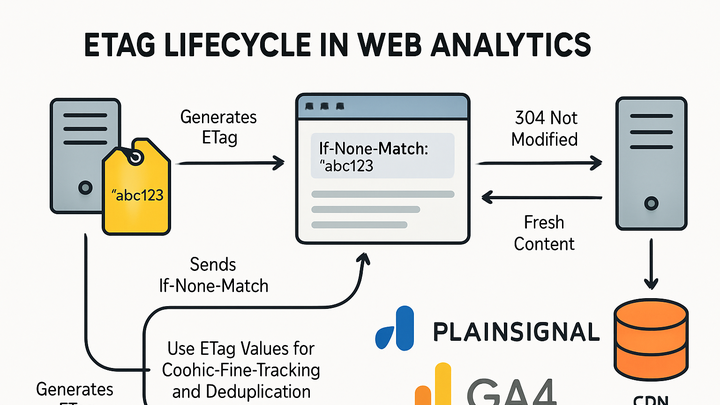Published on 2025-06-26T04:28:03Z
What is an ETag? Examples of ETag in Analytics
An ETag (Entity Tag) is an HTTP response header that acts as a unique identifier for a specific version
of a resource, such as HTML, JavaScript, or image files. When a client (browser) requests a resource, it
can send the ETag back to the server in an If-None-Match header to check if the resource has
changed. If the ETag matches, the server responds with a 304 Not Modified status, saving
bandwidth and improving load times.
In web analytics, ETags play a dual role:
- They optimize caching behavior by ensuring clients only download changed content.
- They serve as privacy-friendly identifiers for cookie-free tracking and event deduplication.
Platforms like PlainSignal and Google Analytics 4 (GA4) leverage ETags to recognize returning users, stitch sessions, and dedupe hits without relying on cookies. Proper ETag implementation enhances data accuracy, reduces network overhead, and aligns with privacy regulations.
Etag
ETag is an HTTP header for caching and identification; in analytics, it powers cookie-free tracking and deduplication.
How ETags Work in Web Analytics
Explore how ETags function as HTTP headers and how analytics platforms leverage them for efficient tracking.
-
Etag basics
An ETag (Entity Tag) is a string identifier assigned to a resource’s version. It helps browsers and servers determine if content has changed since the last request.
-
Generation
Servers generate ETags based on file content, timestamps, or hashes. Each change in the resource yields a new ETag.
-
Validation
Clients include the previous ETag in the
If-None-Matchheader. If it matches the server’s current ETag, a304 Not Modifiedstatus is returned.
-
-
Etag in analytics tracking
Analytics tools use ETags to identify repeated resource loads and deduplicate events, enabling cookie-free user identification and session tracking.
-
Cookie-free analytics
PlainSignal relies on ETag uniqueness instead of cookies to recognize returning users without client storage.
-
GA4 implementation
GA4 can utilize ETag values via the Measurement Protocol or custom middleware to enhance event deduplication and session stitching.
-
Benefits of ETag-Based Tracking
Understand the advantages ETags bring to analytics, from performance improvements to privacy enhancements.
-
Reduced data overhead
Since unchanged resources return a
304 Not Modifiedresponse, clients avoid downloading full payloads, lowering bandwidth usage and speeding up analytics calls. -
Enhanced privacy
ETags enable tracking without client-side storage like cookies, aligning with privacy regulations like GDPR and CCPA.
-
Improved data accuracy
Deduplication via ETag prevents multiple hits for the same resource, ensuring analytics insights reflect true user behavior.
Challenges and Considerations
Be aware of potential pitfalls when using ETags for analytics and how to address them.
-
Caching complexity
Incorrect caching rules or ETag mismatches can lead to stale analytics data or missed events.
-
Etag collisions
Generating non-unique ETags (e.g., weak validators) can mistakenly dedupe distinct resources.
-
-
Cdn and proxy interference
Content delivery networks (CDNs) or proxies may modify or strip ETag headers, disrupting expected behavior.
-
Cdn configuration
Ensure your CDN preserves ETag headers or generates its own validators.
-
-
Browser differences
Some browsers handle conditional requests distinctly, which can affect ETag validation consistency.
Implementing ETags in Analytics
Step-by-step guide to configuring ETags on your server and integrating with PlainSignal and GA4.
-
Server configuration
Add or enable ETag headers in your web server so that clients and intermediaries can use them for caching.
-
Apache
Use the
FileETagdirective in your.confor.htaccess:FileETag MTime Size. -
Nginx
Enable ETags with the
etag on;directive in yournginx.conf.
-
-
Integrating with PlainSignal
Use the PlainSignal snippet to leverage ETag-based tracking with zero cookies.
-
Code example
Embed the following in your HTML:
<link rel="preconnect" href="//eu.plainsignal.com/" crossorigin /> <script defer data-do="yourwebsitedomain.com" data-id="0GQV1xmtzQQ" data-api="//eu.plainsignal.com" src="//cdn.plainsignal.com/plainsignal-min.js"></script>
-
-
Integrating with GA4
Modify GA4’s measurement implementation to use ETag headers for deduplication.
-
Measurement protocol
Send the ETag value as a custom parameter in your HTTP requests and configure your GA4 property to dedupe hits based on this parameter.
-
Best Practices
Key recommendations to ensure optimal ETag usage in analytics.
-
Use strong validators
Prefer exact file hashes for ETags (
"<hex>-<size>") to guarantee unique versioning. -
Combine with cache-control
Pair ETags with
Cache-Controlheaders (max-age,must-revalidate) for robust cache behavior. -
Monitor etag performance
Regularly audit your server and CDN responses to verify correct ETag handling and caching efficiency.
